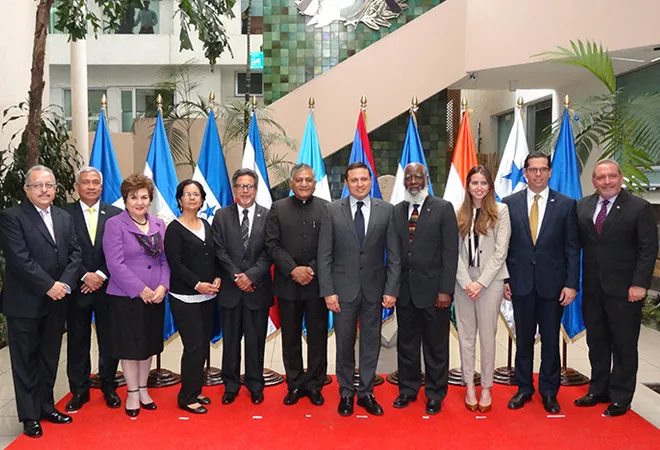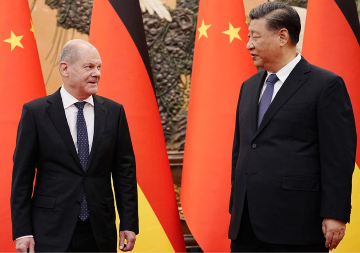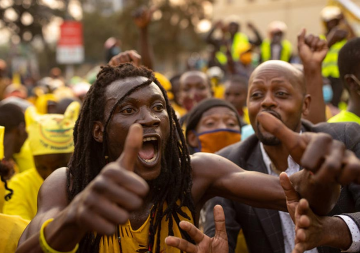
INTRODUCTION <1>
Much was expected from Prime Minister Narendra Modi in developing ties with Latin America—a region that is increasingly gaining salience in India’s foreign policy.<2> In view of India’s growing demand for energy and its interest in seeking overseas investments,<3> Latin America attracts New Delhi’s interest. After all, the region is rich in extractive resources. Given that three G20 economies, i.e. Brazil, Mexico, and Argentina are in Latin America, Indian businesses are keen to tap its expansive market. During the last two decades, India’s trade with Latin American countries has grown substantially and its investments are diversified in sectors such as Information Technology (IT) and manufacturing.<4> Moreover, the region has emerged as an important market for the Indian pharmaceutical and automobile industries.
At the same time, however, there are only a few analysts within India’s strategic community who have stressed the need to upgrade relations with Latin America. They are of the view that China is fast emerging as Latin America’s economic and strategic partner, and that India must begin expanding its own footprint in the region.<5> To its advantage, India’s status as a rising power, its economic growth, as well as its soft power in the form of its cultural and civilisational practices such as yoga<6> have gained traction in Latin America. Yet, despite the heightening political significance of Latin America between 2014–19,<7> it does not emerge as a priority region under the Modi government.
INDIA’S LATIN AMERICAN ENGAGEMENT UNDER MODI
In hindsight, Modi’s intervention in India’s Latin America engagement has been intermittent. As prime minister, Modi visited Latin America only thrice; two of the visits were on the sidelines of the 6th Brazil, Russia, India, China and South Africa (BRICS) summit in Brazil, and the 13th G 20 summit in Argentina. As protests against Venezuelan President Nicolás Maduro intensified in 2019, the crisis posed some challenge to the dynamics of India’s foreign policy. India’s leading hydrocarbon entity, the Oil and Natural Gas Corporation (ONGC) found itself in a difficult position owing to the delay in payment of dues by Venezuela’s Petróleos de Venezuela, S.A. (PDVSA).<8> Added to this, US economic sanctions on Venezuela threatened India’s energy relations with the latter to some degree, even when it has intended to develop energy relations with other states such as Mexico.
INDIA AND MEXICO: SEARCHING FOR A GREATER BONDING
As the second largest economy in the region after Brazil, Mexico has shown some interest in seeking a ‘strategic partnership’<9> with India. Indian enterprises see Mexico as a ‘springboard’ to gain better access to the much larger US market. Mexico is India’s second largest trading partner in Latin America and in 2017-18 bilateral trade was valued at approximately US$8.30 billion.<10> In 2016, India exported more to Mexico than to some countries in its more immediate neighbourhood such as Thailand, Myanmar, and Iran.<11>
Since Mexico opened its oil sector for foreign participation in 2014, New Delhi has viewed it as a viable source of crude oil and associated investments. India’s Minister of State for Petroleum and Natural Gas, Dharmendra Pradhan has expressed interest in purchasing more crude oil from Mexico and investing in its energy sector. In line with this goal, India’s ONGC decided to participate in bidding for Mexico’s oil blocks. In part, India’s outreach to Mexico under Modi derives from the government’s move to diversify the country’s energy sources.
BRAZIL: INDIA’S ENDURING PARTNER IN LATIN AMERICA
India’s relations with Brazil stand out in Latin America as both are widely regarded as ‘rising powers’ in the international system. Owing to their association in emerging multilateral groupings such as the BRICS and IBSA<12>, both sides envision greater cooperation in multiple areas.
In Latin America, Brazil was instrumental in guiding India in the negations for the India-MERCOSUR Preferential Trade Agreement (PTA) under which reciprocal tariff preferences are offered between the signatory countries.<13>,<14>
India’s total trade with MERCOSUR countries in 2017-18 amounted to over US$10.5 billion.<15> Soon after the 8th BRICS summit in 2016, India signed a Social Security Agreement with Brazil which would exempt expatriates from either country from paying social security contributions if they are already doing so in their home country.<16> Cooperation in key areas like energy—where potential is high—remained insignificant during Modi’s tenure. Since investing more than US$400 million in Brazil in 2006, ONGC floated tender in 2018 to sell its BC-10 block investment.<17> While India’s trade with Brazil grew by over 20 percent and amounted to little over US$11 billion in 2014-15, the bilateral trade slumped to just over US$8.50 billion in 2017-18.<18>
INDIA AND ARGENTINA: EXPANDING HORIZONS
In times when relations between Argentina and China have grown rapidly, the 2019 visit of Argentine President, Mauricio Macri to India may yet prove crucial in shaping India-Argentina relations.<19> With Macri’s visit, both sides are exploring ways to step up cooperation in areas such as defence, nuclear energy, and space. In a step forward, the MoU on defence cooperation between Argentina and India could be significant in view of the former’s evolving military cooperation with China. Similar synergy was evident in other strategic areas including Civil Nuclear and Space.
SEEKING AN APPROACH TOWARDS ENGAGING THE REST OF LATIN AMERICA
Traditionally, India’s engagement with Latin American countries has been guided by its role in the Non-Aligned Movement (NAM) apart from being facilitated by the ‘Global South’, which still has some resonance in Latin America. Interestingly, Indian President Ram Nath Kovind in conclusion of his Cuba visit delivered a speech on “India and the Global South” at the University of Havana.<20>
Earlier in 2016, India’s Vice President Venkaiah Naidu attended the NAM summit in Venezuela, another country which identifies itself with the Global South. These visits underscore the legacy of India’s association with the NAM and that it continues to influence New Delhi’s engagement with Latin America. It seems that the Modi government intends to preserve this dynamic during its tenure.
Elsewhere in Latin America, India is looking to expand its economic footprint. For one, New Delhi’s outreach to Chile is noteworthy. Chile is India’s sixth largest trading partner in the region and its advantageous geographical position incentivises New Delhi to explore broader economic cooperation with Santiago. India and Peru, meanwhile, are deliberating on a comprehensive free trade agreement for which three rounds of discussions have taken place so far.
Apart from this, India appears to be focusing on developing relations with multiple Latin American nations in the sphere of energy. India is looking at Guatemala to join its International Solar Alliance initiative in which several Latin American countries including Brazil, Costa Rica, Suriname, and Venezuela are members. Likewise, in Peru, Vice President Naidu emphasised cooperation in renewable energy. Peru is a founding member of the International Solar Alliance. Other Latin American countries such as Panama are recognising India’s growing capabilities in specific areas and seek to gain from agencies such as the Indian Space Research Organization which is interested in setting up a Telemetry, Tracking and Tele Command (TTC) Earth station there.
CONCLUSION
Overall, the Modi government has shown interest in diversifying India’s engagement in Latin America, and while India’s interest in Latin America is relatively new, the relationship has been on an upward trajectory. Latin American countries such as Mexico, Brazil, Panama, and Argentina are seeking cooperation with India in new sectors such as space, science and technology, and defence—this represents a positive dynamic from New Delhi’s viewpoint. However, in quantitative terms, trade between India and Latin America remains modest despite registering growth in recent years. Also, it would seem that India has not made much of an effort to engage Caribbean countries such as Trinidad and Tobago, Haiti and Dominica. A dedicated foreign policy
Figure 20: India’s Trade Profile with Brazil, Mexico and Argentina in 2014–15
 Note: Figures are in US$ billions.
Note: Figures are in US$ billions.
Source: Data retrieved from the Government of India, Ministry of Commerce, Export-Import Data Bank.
vision towards Latin America is expected from the new government, apart from marshalling more resources towards expanding its diplomatic footprint in the region.
Table 6: High-Level Diplomatic Interactions between India and Latin American Countries

This article originally appeared in special report Looking Back looking Ahead.
<1> In Indian official documents, Latin America comprises 33 countries, including Brazil and the Caribbean countries.
<2> Ronak D. Desai, “
A New Era for India-Latin America Relations?”
Forbes, 15 June 2015.
<3> Bilal Abdi, “Why Oil Is Going to Remain India’s Most Difficult Conundrum in Times to Come”,
The Economic Times, 27 September 2018.
<4> Hari Seshasayee, “
India’s Rising Presence in Latin America”,
Americas Quarterly, accessed 7 June 2019.
<5> Ketan Mehta, “
China in Latin America: A Rising Power’s Forays into US Backyard,” ORF Occasional Paper 141, January 2018.
<6> “
The Magic of Yoga Takes Over in Latin America,” Press Information Bureau, Government of India, 19 June 2017.
<7> The period between 2014 and 2018 was significant as elections were held in multiple Latin American countries, including Peru (2016), Chile (2017) and in Columbia, Brazil and Mexico (2018).
<8> PTI, “
Venezuela Starts Clearing ONGC Videsh Ltd’s $449 Million Dues,”
The Economic Times, 5 December 2018.
<9> “
India-Mexico Relations,” Ministry of External Affairs, Government of India, October 2017.
<10> Calculated using data retrieved from, Government of India, Ministry of Commerce,
Export-Import Data Bank.
<11> R. Vishwanathan, “
Why It’s Important for India to Trade with Latin America,”
The Wire, 21 July 2017.
<12> The acronym IBSA stands for India, Brazil and South Africa.
<13> “
MERCOSUR Preferential Trade Agreement (PTA) Negotiations,” Ministry of Commerce, Government of India, accessed 12 June 2019.
<14> MERCOSUR member countries are Argentina, Brazil, Uruguay, Paraguay, Uruguay and Venezuela.
<15> Calculated using data retrieved from Government of India, Ministry of Commerce,
Export-Import Data Bank.
<16> “
Social Security Agreement Between India and Brazil,” Ministry of External Affairs, Government of India, 16 March 2017.
<17> Reuters, “ONGC Floats First Tender to Sell Brazil’s Ostra Crude,”
The Economic Times, 5 May 2018.
<18> Using data retrieved from Government of India, Ministry of Commerce,
Export-Import Data Bank.
<19> “
State Visit of President of Argentina to India (February 17-19, 2019),” Ministry of External Affairs, Government of India, 14 February 2019.
<20> “
India’s President Visits Cuba,”
EFE, 22 June 2018.
The views expressed above belong to the author(s). ORF research and analyses now available on Telegram! Click here to access our curated content — blogs, longforms and interviews.




 Note: Figures are in US$ billions.
Note: Figures are in US$ billions.
 PREV
PREV


